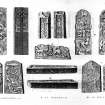Aberlemno 3
Cross Base (Pictish), Cross Slab (Pictish), Pictish Symbol Stone (Pictish)
Site Name Aberlemno 3
Classification Cross Base (Pictish), Cross Slab (Pictish), Pictish Symbol Stone (Pictish)
Canmore ID 34863
Site Number NO55NW 8.03
NGR NO 52243 55869
Datum OSGB36 - NGR
Permalink http://canmore.org.uk/site/34863
- Council Angus
- Parish Aberlemno
- Former Region Tayside
- Former District Angus
- Former County Angus
Aberlemno 3, Angus, Pictish cross-slab
Measurements: H 2.82m, W 1.02m, D 0.20m
Stone type: sandstone
Place of discovery: NO 52245 55868
Present location: in situ beside the road at Aberlemno.
Evidence for discovery: first recorded in 1569, with a cairn of stones beside it, and first illustrated by Gordon in 1726. The stone base was rediscovered in 1893 and implies that the stone is still in its original position, with the cross facing west.
Present condition: damaged at the top and across the upper part of face A, and overall the carving is very weathered.
Description
This is a tall and relatively narrow slab with an improbably slender cross on face A. There is a hint of a shallow pediment at the top. It is carved in relief on four levels within roll-moulded edges. On face A the cross-head gives the impression of a jewelled cross, with raised rectangular bosses on each arm terminal and hollow interiors. At the centre is a raised boss, and there is an encircled boss in the spaces between the arms and the great ring linking the arm. All these raised surfaces are intricately carved with interlace designs. The shaft of the cross appears to have borne a single long panel of interlace. The background to the cross is also filled with ornament, including what may be zoomorphic interlace beneath the side-arms of the cross. Set in roll-moulded panels on either side of the shaft are two adoring angels or cherubims with multiple drooping wings, their heads bent over their books. One of the right-hand angel’s feet overlies the frame. Then there is a panel of diagonal interlace on both sides, and animals at the bottom. On the left a quadruped with head hanging down towards a deer lying down with its head arched back, and on the right two beasts and a pair of human legs hanging from the lower creature.
Face C is divided into four panels. At the top are two very large Pictish symbols, a crescent and V-rod over a double disc and Z-rod, both heavily decorated. The central panel holds a lively hunting scene, with four horsemen riding briskly to the left, above two deer who are being mauled by four hounds. Two trumpeters top right herald the importance of the main huntsman, and a figure on the left with a square shield is thought to represent David, thus underlining his royal status. David appears again in the bottom right panel rending the jaws of a lion, with a sheep and harp beside him. On the left is a centaur with a tree branch with spiral foliage.
The stone is set in a rectangular socket in a plain rectangular base.
Date range: ninth century.
Primary references: Gordon 1726, pl 53; Skene 1832, 29; ECMS pt 3, 214-15; Fraser 2008, no 51.3.
Desk-based information compiled by A Ritchie 2018
Note (1983)
Aberlemno 3 NO 5225 5586 NO55NW 8.3
An ornate Class II Pictish cross-slab, which stands on the roadside 60m SSW of (N055NW 8.01). The carvings on the back include a crescent with V-rod, a double disc with Z-rod, and a hunting scene.
RCAHMS 1983
(Stuart 1856, 24-5, plates lxxx, lxxxi; Jervise 1857a, 192; Allen and Anderson 1903, iii, 214-15).
Project (13 May 2025)
Placeholder event ahead of GPR Survey
Ground Penetrating Radar (13 May 2025)
Placeholder event ahead of GPR survey
Geophysical Survey (13 May 2025)
Placeholder event ahead of GPR survey


























































































































































